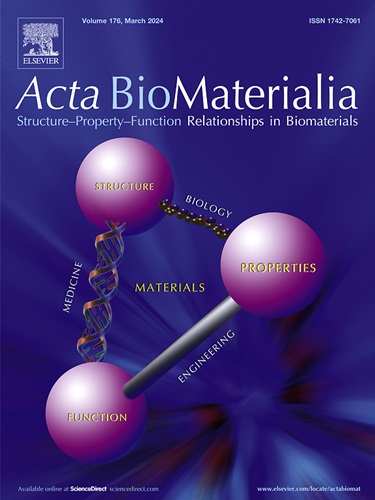Enhancing inter-system crossing efficiency of NIR-II emitting type-I photosensitizers for tumor ferroptosis induction
IF 9.6
1区 医学
Q1 ENGINEERING, BIOMEDICAL
引用次数: 0
Abstract
Ferroptosis, an iron-dependent form of regulated cell death driven by lipid peroxidation (LPO), represents a compelling avenue for cancer therapy. Photodynamic therapy (PDT), which relies on the production of LPO-reactive oxygen species (ROS), has emerged as a potent therapeutic strategy. However, the clinical efficacy of conventional photosensitizers (PSs) is frequently constrained by tumor hypoxia, which intensifies local oxygen deficiency and diminishes PDT performance. In contrast, Type I PDT facilitates the generation of cytotoxic ROS, such as superoxide (O2−•) through electron transfer mechanisms, offering enhanced oxygen independence and improved therapeutic efficacy. In this study, we introduce a near-infrared (NIR)- activated Type I PS, TPP-TPA, designed via a receptor-engineering strategy. TPP-TPA exhibits robust NIR absorption and NIR-II fluorescence emission, enabling efficient Type I ROS production that induces ferroptosis in 4T1 breast cancer cells. This work establishes a promising approach for cancer therapy and imaging, addressing key limitations of traditional PDT while offering significant potential for clinical translation.
Statement of significance
This study presents a near-infrared (NIR)-activated Type I photosensitizer (PS), TPP-TPA, designed via a receptor-engineering strategy to overcome the limitations of conventional photodynamic therapy (PDT). By efficiently generating Type I reactive oxygen species (ROS) under NIR activation, TPP-TPA NPs induce ferroptosis in breast cancer cells, offering enhanced oxygen independence and improved therapeutic efficacy. This work advances cancer therapy and imaging by addressing the challenges of tumor hypoxia in PDT, highlighting its potential for clinical translation.

提高NIR-II发射型光敏剂诱导肿瘤铁下垂的系统间交叉效率。
铁下垂是一种由脂质过氧化(LPO)驱动的铁依赖性细胞死亡形式,代表了癌症治疗的一个引人注目的途径。光动力疗法(PDT)依赖于lpo -活性氧(ROS)的产生,已成为一种有效的治疗策略。然而,常规光敏剂(PSs)的临床疗效经常受到肿瘤缺氧的限制,从而加剧局部缺氧并降低PDT性能。相比之下,I型PDT通过电子传递机制促进细胞毒性ROS的产生,如超氧化物(O2-•),增强氧独立性,提高治疗效果。在这项研究中,我们介绍了一种近红外(NIR)激活的I型PS, TPP-TPA,通过受体工程策略设计。TPP-TPA表现出强大的近红外吸收和NIR- ii荧光发射,能够有效地产生I型ROS,诱导4T1乳腺癌细胞铁下垂。这项工作为癌症治疗和成像建立了一种有前途的方法,解决了传统PDT的关键局限性,同时为临床转化提供了巨大的潜力。意义声明:本研究提出了一种近红外(NIR)激活的I型光敏剂(PS), TPP-TPA,通过受体工程策略设计,克服了传统光动力疗法(PDT)的局限性。TPP-TPA NPs通过在近红外激活下有效产生I型活性氧(ROS),诱导乳腺癌细胞铁下垂,增强氧独立性,提高治疗效果。这项工作通过解决PDT中肿瘤缺氧的挑战来推进癌症治疗和成像,突出其临床转化的潜力。
本文章由计算机程序翻译,如有差异,请以英文原文为准。
求助全文
约1分钟内获得全文
求助全文
来源期刊

Acta Biomaterialia
工程技术-材料科学:生物材料
CiteScore
16.80
自引率
3.10%
发文量
776
审稿时长
30 days
期刊介绍:
Acta Biomaterialia is a monthly peer-reviewed scientific journal published by Elsevier. The journal was established in January 2005. The editor-in-chief is W.R. Wagner (University of Pittsburgh). The journal covers research in biomaterials science, including the interrelationship of biomaterial structure and function from macroscale to nanoscale. Topical coverage includes biomedical and biocompatible materials.
 求助内容:
求助内容: 应助结果提醒方式:
应助结果提醒方式:


